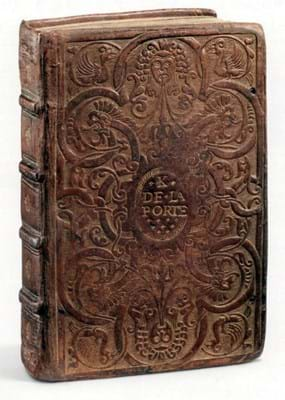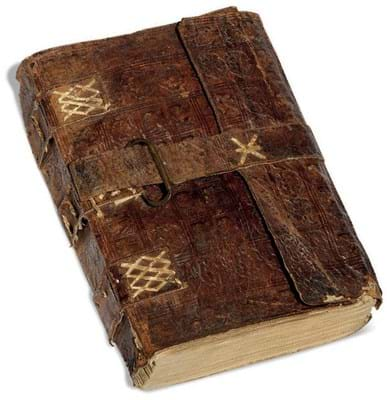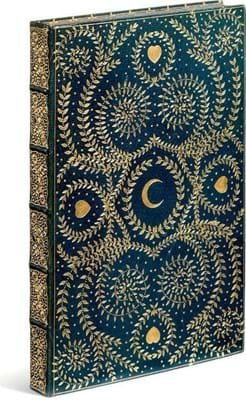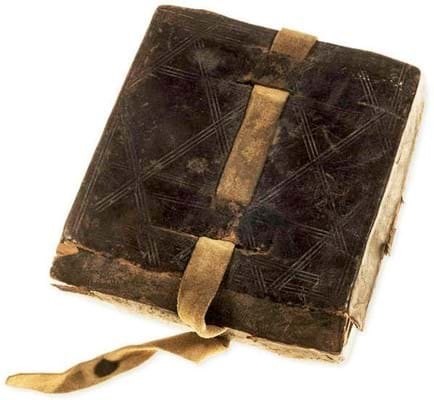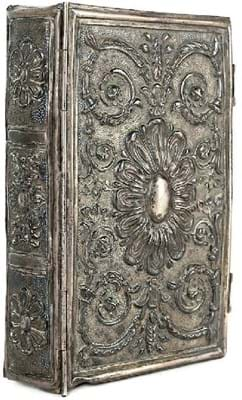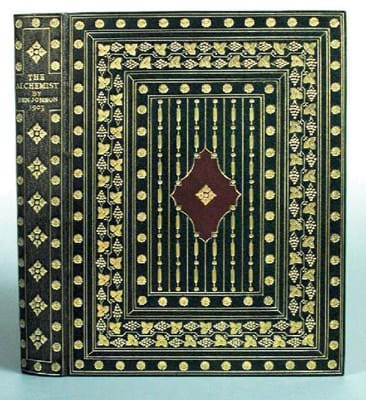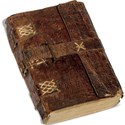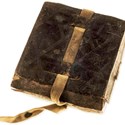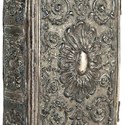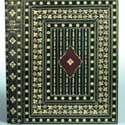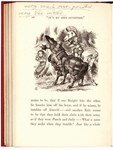A 20th century binding from a recent US sale, one that was accompanied by a fascinating and revealing letter from the English firm that produced it, is separately featured bottom.
1. The richly illuminated pages of a late 16th century Book of Hours from Lyons or Bourges that was part of a Christie’s (25/20/12.5% buyer’s premium) sale of July 11 were the main attraction, but this little devotional work also boasted a very fine French binding.
Dating from the mid-16th century, it is stamped on both covers with the name ‘K de la Porte’, which the saleroom suggests is probably Charles de Laporte de Puyferrat of Saint-Aster in the Dordogne, who died in the 1590s and was an ancestor of the vendor. It sold for £68,000.
2. Though a number of editions were printed at the end of the 15th century, copies of a Latin and Dutch Gemma vocabularum are now of the greatest rarity.
This 1497 example, printed in Deventer by Richardus Pafraet, is beautifully preserved in a contemporary German ledger-style wallet binding of blind tooled flexible calf. Three calf strips with white leather thongs are attached to the spine, the central one extending around to a front buckle. Bearing a 1499 ownership inscription, this copy first belonged to Nikolaus Humbracht, a member of a patrician family of Frankfurt. Estimated at £3000- 5000, it sold instead for £24,000 at Christie’s on July 11.
3. This spectacular crushed blue morocco gilt binding by TJ Cobden-Sanderson, founder of the Doves Bindery and Press, was made for an 1818, first state copy of John Keats’ Endymion.
One of three examples of his work that Cobden-Sanderson entered for an 1887 Society of Arts binding competition, it made £131 when first seen auction – at Sotheby’s in 1901. In the King Street sale of July 11, estimated at £12,000-18,000, it sold instead at £60,000.
4. Not so much a binding as a box or travelling case, this 5in (13cm) square box of blind-stamped calf over a light wooden frame may have been used by a binder or printer to keep small devotional works safe while travelling. It has leather ties that would have been used to attach it to a belt. Printer’s waste used as a lining comes from a theological work by Samuel Collins, which suggests an early 17th century English origin for the case. The box was sold for £4200 by Forum Auctions (25/20/12% buyer’s premium) on July 12.
5.La Vie de Saint-Thérèse..., a translation by Abbot Martial Chanut of St Teresa of Avila’s autobiography, was printed in Paris in 1691 and is seen here in a contemporary French silver binding.
The book itself lacks a few leaves and has other shortcomings of condition, but in a Chiswick Auctions (25/12% buyer’s premium) sale of July 12 it sold at £3000.
6. A July 4 sale held by Cheffins (22.5% buyer’s premium) of Cambridge included a couple of examples of the work of a (retired?) naval officer, Captain CE Gladstone. The catalogue notes only that he died in 1919 and that the books were sent to auction by a descendant. Sold at £1000 was this 1903 edition of Ben Jonson’s The Alchemist in a green morocco gilt binding with pink silk doublures. It is one of 480 copies on handmade paper of a ‘King’s Library’ edition issued by the De la More Press.
7. A 1934 first of Agatha Christie’s Murder on the Orient Express in a later binding of green, brown and cream morocco by Sangorski & Sutcliffe that sold for £4800 at a July 9-10 sale held by Sotheby’s (25/20/12.9% buyer’s premium).
8. Sold for £3200 in the July 9-10 Sotheby’s sale was this 1893 Macmillan edition of Nancy Mitford’s Our Village, illustrated by Hugh Thomson. Bound in full green levant morocco by Sangorski & Sutcliffe, it is tooled with gilt and floral designs and has lavender pigskin doublures and lavender silk endpapers.
'Super in every regard'
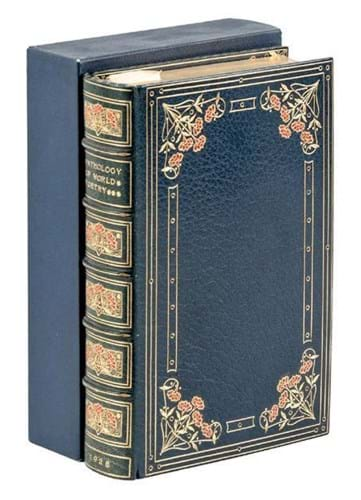
An Anthology of World Poetry edited by Carl van Doren and published in New York in 1928, bound by London firm W Root & Son - at $2400 (£1875) at PBA Galleries.
Offered as part of a PBA Galleries (20/15% buyer’s premium) sale of August 9 were a number of books bound for a collector (thought to be American) by the well-known London firm, W Root & Son.
One of them, An Anthology of World Poetry edited by Carl van Doren and published in New York in 1928 (above), made rather more than expected at $2400 (£1875), but it is the letter that accompanied it that catches the attention.
Sent parcel post, the book had been insured for £10 – though a footnote detailing the work involved reveals that the actual cost to the client was £6 19s 9d.
The Root letter acknowledges that this is the most expensive binding the firm had yet done for its client, but notes that he had wanted it to be “super in every regard consonant with artistic effect” and assures him that W Root & Son had done its very best.
Observing that such work is very time consuming, the firm points out that “there are 79 inlaid (Red) tools and many hundreds of small Gold dots on the Back Panels, and these, flowers, as also the dots, are tooled singly. Indeed the whole design is made up from single small tools.”


